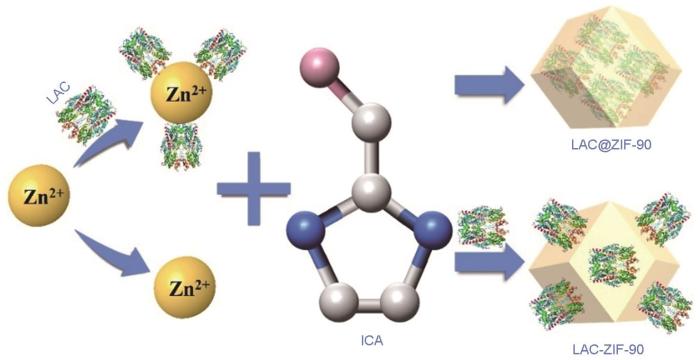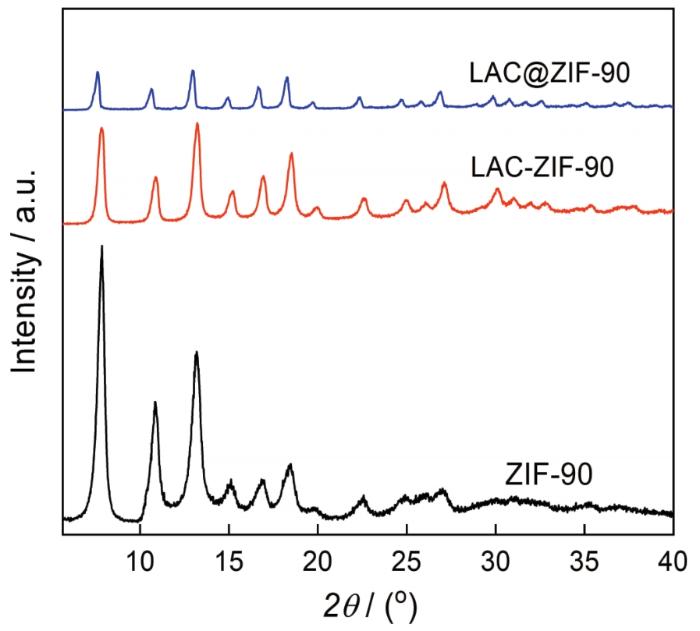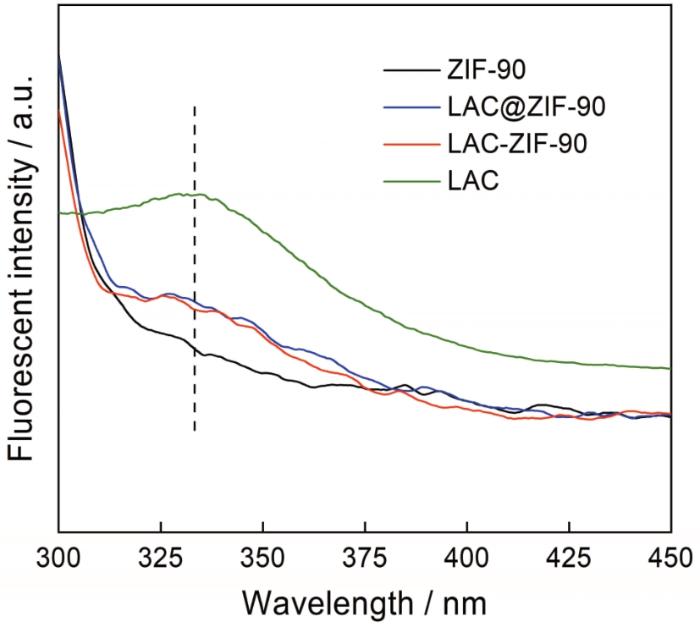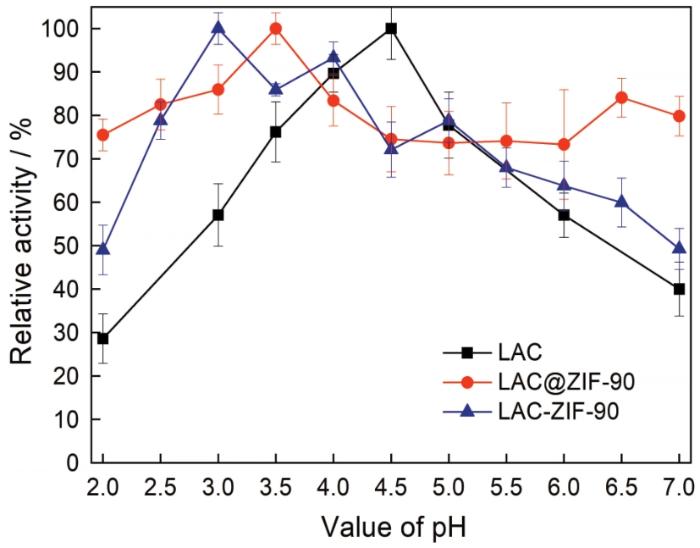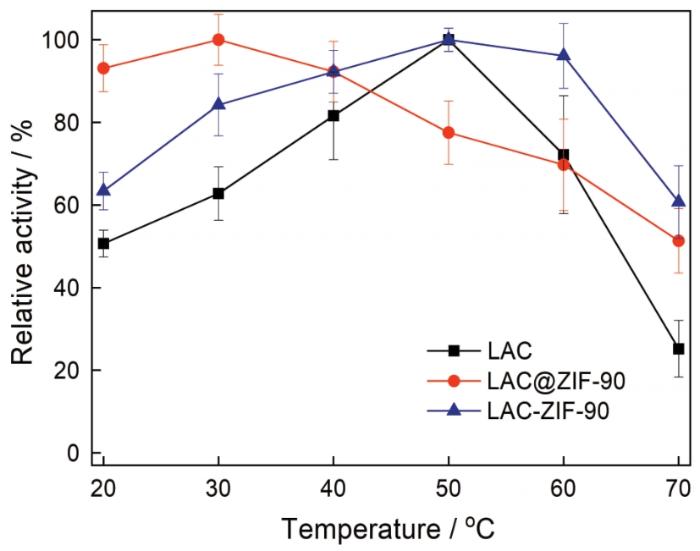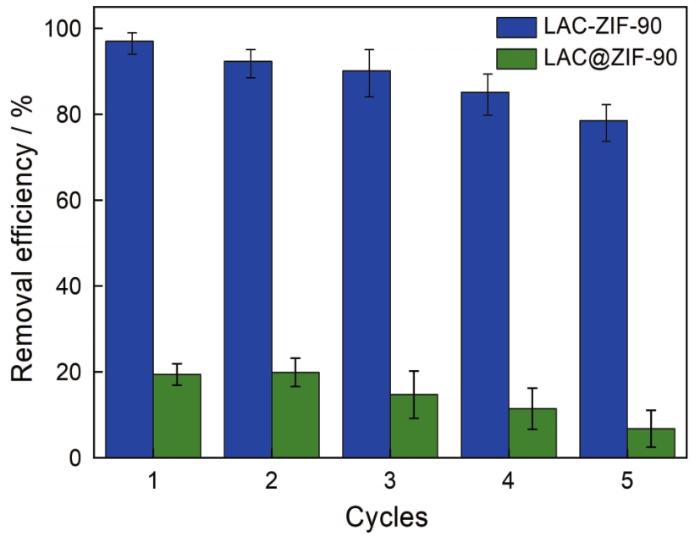苯的两个邻位氢被羟基取代,生成邻苯二酚。邻苯二酚是一种重要的化学原料,广泛应用在橡胶、医药、农药、化妆品、纺织品、染料等领域。但是邻苯二酚有毒[1],排放不当会污染生态环境和危害人类健康[2]。因此,邻苯二酚被列为工业废水中一类重要的污染物[3]。漆酶是一种含铜的多酚氧化酶[4],其结构中的铜离子可氧化酚类底物。漆酶中的底物作为电子供体,而分子氧作为电子受体被还原成水[5],整个催化反应过程是绿色且环保的[6, 7]。因此,漆酶具有催化降解环境中有毒有害酚类物质的能力,可用于去除邻苯二酚。Chen等[8]研究了漆酶对邻苯二酚的氧化和芳香环开环的自由基过程,以开发漆酶降解邻苯二酚。Pang等[9]将漆酶固定在多种碳纳米材料上作为生物催化剂,研究了其对水中双酚A和邻苯二酚的降解。
但是,漆酶作为生物催化剂不能重复使用、稳定性差(易受酸碱性、温度及无机离子等的破坏导致变性失活)和成本高使其使用受到限制[10]。漆酶的固定化,是克服这些不足的有效手段。与游离酶相比,固定化漆酶可提高酶分子的耐受温度、pH值和有机溶剂等变性条件的能力,从而提高使用稳定性。同时,固定后的漆酶被载体封装或与载体结合在一起,反应完成后进行过滤或离心分离方式即可实现回收再利用。
制备固定化漆酶的首要条件是选择合适的载体[11],因为固定载体的性能和固定方式的不同也影响固定化酶的使用效果[10]。沸石咪唑骨架材料(ZIFs)[12]是一类由Zn(Ⅱ)或Co(Ⅱ)与咪唑配体反应合成的新型金属有机框架材料(MOFs),具有类沸石结构,其比表面积大、孔体积大、孔道结构均匀,而且还具有较高的热稳定性和化学稳定性。因此,沸石咪唑骨架材料广泛应用在很多领域,例如气体吸附、能量存储设备、催化[13]、分子传感以及用作生物大分子(如DNA[14]、药物和酶[15, 16])的固定平台。与其他的固定化策略相比,采用MOF材料固定漆酶,不仅能显著提高酶的稳定性和可回收性,还能为漆酶提供大量活性位点,有利于漆酶催化反应的进行[17]。使漆酶与Zn2+形成配位键再与有机配体自组装成MOF框架结构,可将漆酶原位封装在ZIFs内[18, 19]。利用MOFs材料优良的吸附性及漆酶与MOFs之间的物理相互作用,可将漆酶固定在ZIFs表面[19, 20]。ZIF-90是Zn(Ⅱ)和咪唑-2-甲醛(ICA)自组装成的金属有机框架材料[21, 22],具有较高的热稳定性和化学稳定性,并且可在生物相容的条件下合成。鉴于此,本文以ZIF-90作为LAC分子的固定载体,采用表面吸附和内部封装方法将LAC分子固定在ZIF-90的表面和内部制备出LAC-ZIF-90和LAC@ZIF-90,研究其微观形貌、结构及使用稳定性,并以邻苯二酚为目标污染物研究漆酶对邻苯二酚的降解性能。
1 实验方法
1.1 固定化漆酶的制备
图1给出了LAC@ZIF-90和LAC-ZIF-90的合成示意图。文献[21, 23]中的方法合成ZIF-90内部封装固定漆酶(LAC@ZIF-90):将480 mg的咪唑-2-甲醛(ICA,纯度98%)和50 mg的聚乙烯吡咯烷酮(PVP,分析纯)加入蒸馏水中,在80℃水浴加热溶解。将其降温至室温后将适量1g/L的漆酶溶液(用pH值为4.5的醋酸-醋酸钠缓冲液配置)加入混合溶液中,轻微震荡10 min。然后加入3 mL(371.3 mg)的六水合硝酸锌(Zn(NO3)2·6(H2O),分析纯)溶液于混合溶液中,反应10 min。最后进行离心分离将反应产物清洗并真空干燥,得到LAC@ZIF-90。
图1
图1
LAC@ZIF-90和LAC-ZIF-90的合成示意图
Fig.1
Schematic illustration showing the synthesis of LAC@ZIF-90 and LAC-ZIF-90
ZIF-90表面吸附固定漆酶(LAC-ZIF-90)的制备:称取480 mg的ICA和50 mg PVP加入蒸馏水中,在80℃溶解后降温至室温,然后加入3 ml的硝酸锌溶液,反应10 min后离心清洗。然后将产物浸泡在1 g/L的漆酶(LAC,≥0.5 U/mg)溶液中6 h以固定漆酶,最后再次离心清洗以去除未固定的游离漆酶,在40℃干燥后得到LAC-ZIF-90。
1.2 游离漆酶和固定化漆酶活性的测试
将LAC,LAC@ZIF-90和LAC-ZIF-90分别分散于醋酸-醋酸钠缓冲液中,将适量酶溶液与0.5 mM的2,2-联氮-二(3-乙基-苯并噻唑-6-磺酸)二铵盐(ABTS,纯度98%)溶液反应一定时间后,采用紫外分光光度计(UV-2600)测定反应液在420 nm处的吸光度值,则酶的相对活性为
其中Rr为酶的相对活性,A为测定条件下的吸光度,Amax为测定某一性能时的最大吸光度[10]。
1.3 固定化酶的表征
用扫描电子显微镜(SEM,SU8000)、激光共聚焦显微镜(CLSM,TCS SP8)、X射线衍射(XRD,D2 PHASER)、傅里叶红外变换光谱仪(FT-IR,Nicolet is10)、荧光分光光度计(日立F-7000)、全自动比表面积及孔隙度分析仪(BET,TriStarⅡ3020)等手段表征固定化漆酶的性能。因ZIF-90为弱导电物质,需先在样品表面喷金以增强其导电性,SEM观察时电子束加速加压为5 kV。用CLSM观察样品中漆酶的分布,观察前对漆酶进行标记:将LAC分散在pH=4.5的醋酸-醋酸钠缓冲液中,将20 mM的异硫氰酸荧光素(FITC,分析纯)溶液加入LAC溶液中对LAC分子进行标记,在4℃避光条件下储存,静置24 h后制样,然后对样品进行观察。X射线衍射仪的单色器为Cu靶Kɑ 线,扫描角度范围为5°~50°,步长为0.2。使用Nicolet is10红外光谱仪测试样品的红外光谱,扫描范围为500~4000 cm-1。用全自动比表面积及孔隙度分析仪测量比表面积及孔特征,测量前取0.15 g样品于BET管中,在60℃预处理6 h,然后在低温下进行N2吸脱附测试。使用日立F-7000荧光分光光度计测定样品的荧光光谱,激发波长为280 nm,扫描溶液样品在300~450 nm范围内的荧光发射光谱,调狭缝宽5 nm。
1.4 固定酶对邻苯二酚降解性能的测试
用高效液相色谱仪(HPLC,岛津LC-20AD)分析样品中邻苯二酚的含量,色谱柱:Ultimate Plus-C18(4.6 mm×150 mm,3.5
对照溶液:精密称取适量邻苯二酚(分析纯)对照品,加水溶解稀释至不同浓度以绘制标准曲线。
样品溶液:精密移取50
取一定量制备好的LAC@ZIF-90和LAC-ZIF-90投加到邻苯二酚溶液(pH=4.5,100
其中Q为邻苯二酚去除率,Co为邻苯二酚的初始浓度,Ce为邻苯二酚的剩余浓度。
2 结果和讨论
2.1 ZIF-90和固定漆酶后LAC@ZIF-90、LAC-ZIF-90的表面形态
图2给出了ZIF-90和固定漆酶后的LAC@ZIF-90、LAC-ZIF-90复合材料的SEM照片。可以看出,固定了漆酶后的LAC@ZIF-90、LAC-ZIF-90形貌与ZIF-90[23, 24]相同,均为直径23
图2
图2
ZIF-90、LAC@ZIF-90和LAC-ZIF-90的SEM照片
Fig.2
SEM images of ZIF-90 (a), LAC@ZIF-90 (b) and LAC-ZIF-90 (c)
图3
图3
CLSM显示LAC-ZIF-90(a,b,c)和LAC@ZIF-90(d,e,f)的荧光、明场和重叠图像
Fig.3
CLSM showing the fluorescence, bright field and overlay images of LAC-ZIF-90 (a, b, c) and LAC@ZIF-90 (d, e, f)
2.2 ZIF-90、LAC@ZIF-90和LAC-ZIF-90复合材料的结构
图4给出了ZIF-90、LAC@ZIF-90和LAC-ZIF-90的XRD谱。图4表明,合成的ZIF-90的衍射峰的位置与文献[25, 26]中的主要特征峰位置相一致。位于7.4°的特征衍射峰由(011)晶面产生,其余从左到右分别位于10.4°、12.8°、14.7°、16.5°、18.0°、22.1°、24.5°、26.7°、29.7°、30.5°、32.4°的特征衍射峰分别由(011),(200),(112),(022),(013),(222),(114),(233)和(134)晶面产生。这些结果表明,已经成功地合成出ZIF-90。从图4还可见,固定了LAC后的LAC@ZIF-90和LAC-ZIF-90复合材料有一系列与ZIF-90一致的衍射峰,且峰的位置没有变化。这表明,LAC@ZIF-90和LAC-ZIF-90保留了ZIF-90的结构,漆酶的负载对ZIF-90的晶体结构及框架结构没有影响。
图4
图4
ZIF-90、LAC@ZIF-90和LAC-ZIF-90的XRD谱
Fig.4
XRD spectra of ZIF-90、LAC@ZIF-90 and LAC-ZIF-90
2.3 红外光谱
图5
图5
ZIF-90、LAC@ZIF-90、LAC-ZIF-90和游离LAC的FTIR谱
Fig.5
FTIR spectra of ZIF-90、LAC@ZIF-90、LAC-ZIF-90 and free LAC
2.4 LAC的构象变化
图6给出了游离LAC、ZIF-90晶体和LAC/ZIF-90复合材料在λmax=333 nm处的荧光光谱。可以看出,LAC-ZIF-90和LAC@ZIF-90具有与游离LAC分子基本相同的发射曲线,而ZIF-90晶体则显示出不同的曲线。这表明,无论LAC分子是固定在ZIF-90表面还是封装在内部,都没有影响酶蛋白的构象。
图6
图6
ZIF-90、LAC@ZIF-90、LAC-ZIF-90和游离LAC的荧光光谱
Fig.6
Fluorescence spectroscopy of ZIF-90、LAC@ZIF-90、LAC-ZIF-90 and free LAC
2.5 比表面积和孔结构
表1列出了ZIF-90和LAC/ZIF-90复合材料的比表面积及孔隙结构特征。可以看出,ZIF-90的比表面积为721.4970 m2/g,表明ZIF-90晶体具有较高的吸附性能。由表1可见,ZIF-90的孔径约为4.6218 nm,而酶生物分子的尺寸一般为几纳米到几十纳米。这表明,在多种MOF固定酶策略当中,表面吸附和内部封装是固定漆酶的有效方法[19]。LAC@ZIF-90和LAC-ZIF-90复合材料的比表面积分别为525.6278 m2/g、123.4171 m2/g,与ZIF-90相比,LAC@ZIF-90的比表面积略有下降,而LAC-ZIF-90的比表面积则显著下降。其原因是,ZIF-90晶体的一部分孔被吸附在表面的LAC分子堵塞,LAC分子占据了孔体积的一部分,使其孔体积与ZIF-90相比也显著下降,只有0.054 cm3/g。
表1 LAC、LAC-ZIF-90和LAC@ZIF-90的孔隙特征
Table 1
| Particles | BET Surface area/m2·g-1 | Langmuir surface area/m2·g-1 | Pore volume /cm3·g-1 | Pore size/nm |
|---|---|---|---|---|
| ZIF-90 | 721.4970 | 1104.6600 | 0.338 | 4.6218 |
| LAC@ZIF-90 | 525.6278 | 802.7956 | 0.244 | 4.4410 |
| LAC-ZIF-90 | 123.4171 | 199.8178 | 0.054 | 3.8030 |
2.6 固定化漆酶的稳定性
为了比较游离漆酶和固定化漆酶在不同pH条件下的稳定性,将LAC、LAC-ZIF-90和LAC@ZIF-90分别分散于不同pH值(pH值分别为2、2.5、3、3.5、4、4.5、5、5.5、6、6.5、7)的缓冲液中,在室温条件下培育8 h后分别测定其进行相对活性。图7表明,游离漆酶的最适pH值为4.5,LAC-ZIF-90、LAC@ZIF-90的最适pH值分别为3和3.5,可见固定化酶与游离漆酶的最适pH均在酸性条件下,ZIF-90的固定没有影响酶蛋白的构象。pH值为2~7时游离漆酶和固定化漆酶的相对活性体现出较大的差异,固定化漆酶的活性高于游离漆酶。这表明,固定在ZIF-90上的漆酶在较宽的pH值范围内表现出更好的适应性,即固定后漆酶对pH值的耐受能力增强,酸碱稳定性提高。
图7
为了比较游离漆酶及固定化漆酶在不同温度条件下的稳定性,取多份LAC、LAC-ZIF-90和LAC@ZIF-90分别分散于pH=4.5的缓冲液中,并分别置于不同温度(温度分别为20℃、30℃、40℃、50℃、60℃、70℃)的水浴中恒温一段时间。其相对活性的测定结果,如图8所示。可以看出,在20℃~70℃游离LAC、LAC-ZIF-90和LAC@ZIF-90的活性均随着温度的升高而提高,并分别在55℃、50℃、30℃达到最高值,随着温度的进一步提高活性又呈下降趋势。但是,固定化漆酶的活性随温度变化的趋势比游离漆酶的趋势相对更平缓。这表明,在较宽的温度范围内LAC@ZIF-90、LAC-ZIF-90的稳定性优于游离漆酶。其原因是,与游离漆酶相比,固定化漆酶受温度的影响较小。ZIF-90具有很好的热稳定性,与漆酶结合后在一定程度上稳定了漆酶的构象,使其受温度的影响变小,表明固定后漆酶具有较高的热稳定性。
图8
图8
温度对固定漆酶活性的影响
Fig.8
Effect of temperature on the activity of immobilized laccase
2.7 固定化漆酶对邻苯二酚的去除性能和重复使用
分别测试了LAC@ZIF-90和LAC-ZIF-90对邻苯二酚的去除率,设置游离漆酶和ZIF-90作为空白对照组,结果如图9所示。ZIF-90对照组的邻苯二酚含量略有减少,主要得益于MOF材料高比表面积对酚类物质的吸附作用。LAC对酚类物质的降解效果最明显,因为游离漆酶的绝对活性较高,对酚类物质降解的效果优异。而在最初的15 min,LAC-ZIF-90和LAC@ZIF-90对邻苯二酚的去除率分别是84.4%和4.5%;降解时间达到6 h时LAC-ZIF-90和LAC@ZIF-90对邻苯二酚的去除率达到97%和19.4%。这表明,LAC-ZIF-90对邻苯二酚的去除效果明显优于LAC@ZIF-90。其原因是,LAC@ZIF-90的比表面积下降且孔体积与孔径小,从而限制了小分子的扩散和传质效率,增大了传质阻力而使邻苯二酚底物与LAC@ZIF-90内部的漆酶大分子接触机率不佳。而LAC-ZIF-90与底物直接接触,能更好地地去除水中的邻苯二酚。
图9
图9
游离漆酶、固定漆酶以及ZIF-90对邻苯二酚的去除性能
Fig.9
Removal of catechol by free laccase、immobilized laccase and ZIF-90
将适量的LAC@ZIF-90和LAC-ZIF-90投加到邻苯二酚溶液(pH=4.5,100
图10
3 结论
(1) 用基于内部封装和物理吸附方法可合成LAC@ZIF-90、LAC-ZIF-90复合材料,具有介孔结构的金属有机框架ZIF-90对漆酶的固定效果优异,漆酶固定后分子内酶蛋白的构象没有明显的改变。
(2) LAC@ZIF-90、LAC-ZIF-90的pH值稳定性及热稳定性均优于游离漆酶,金属有机框架固定漆酶显著提高了酶的使用稳定性,扩展了漆酶应对不同pH值和温度变化的能力。
(3) LAC-ZIF-90和LAC@ZIF-90的最适pH值分别为3、3.5,在最适pH值条件下震荡6 h对邻苯二酚的去除效果分别为97%和19.4%,表明LAC-ZIF-90复合材料对邻苯二酚的去除性能良好。LAC-ZIF-90和LAC@ZIF-90经过5次重复使用后仍具有较高的活力,LAC-ZIF-90重复5次后对邻苯二酚的去除率依然高于78%。
参考文献
Chemical properties of catechols and their molecular modes of toxic action in cells, from microorganisms to mammals
[J].
The toxicity and fate of phenolic pollutants in the contaminated soils associated with the oil-shale industry
[J].
Efficient removal mechanism of catechol by Fe2O3 modified montmorillonite
[J].
Fe2O3改性蒙脱土对邻苯二酚的高效去除机理
[J].
Laccase-catalyzed oxidative polymerization of phenolic compounds
[J].
A novel single-enzymatic biofuel cell based on highly flexible conductive bacterial cellulose electrode utilizing pollutants as fuel
[J].
The structure and catalytic reaction mechanism of laccase
[J].
漆酶的结构与催化反应机理
[J].
The properties, functions, catalytic mechanism and applicability of laccase
[J].
漆酶的性质、功能、催化机理和应用
[J].
Radical Mechanism of Laccase-Catalyzed Catechol Ring-Opening
[J].
Degradation of phenolic compounds by laccase immobilized on carbon nanomaterials: Diffusional limitation investigation
[J].Carbon nanoparticles are promising candidates for enzyme immobilization. We investigated enzyme loading and laccase activity on various carbon nanoparticles, fullerene (C60), multi-walled carbon nanotubes (MWNTs), oxidized-MWNTs (O-MWNTs), and graphene oxide (GO). The loading capacity was highest for O-MWNTs and lowest for C60. The activity of laccase on various nanomatrices using 2,2'-azino-bis(3-ethylbenzothiazoline-6-sulfonic acid) (ABTs) as a substrate decreased in the following order: GO>MWNTs>O-MWNTs>C60. We speculated that aggregation of the nanoparticles influenced enzyme loading and activity by reducing the available adsorption space and substrate accessibility. The nanoparticle-immobilized laccase was then used for removal of bisphenol and catechol substrates. Compared to free laccase, the immobilized enzymes had significantly reduced reaction rates. For example, the reaction rate of GO-laccase conjugated with bisphenol or catechol substrates was only 10.28% or 12.33%, respectively, of that of the free enzyme. Considering that there was no obvious structural change observed after enzyme immobilization, nanomatrix-induced diffusional limitation most likely caused the low reaction rates. These results demonstrate that the diffusional limitation induced by the aggregation of carbon nanoparticles cannot be ignored because it can lead to increased reaction times, low efficiency, and high economic costs. Furthermore, this problem is exacerbated when low concentrations of environmental contaminants are used.Copyright © 2014 Elsevier B.V. All rights reserved.
Modified PAN nanofibers immobilized with laccase and catalytic properties
[D].
改性聚丙烯腈纳米纤维漆酶固定化及催化性能的研究
[D].
Enzyme immobilization based on metal organic frameworks and its catalytic performance
[D].
基于金属有机框架物酶的固定化及催化性能研究
[D].
Zeolitic imidazolate framework materials: recent progress in synthesis and applications
[J].
Applications of metal-organic frameworks in heterogeneous supramolecular catalysis
[J].This review summarizes the use of metal-organic frameworks (MOFs) as a versatile supramolecular platform to develop heterogeneous catalysts for a variety of organic reactions, especially for liquid-phase reactions. Following a background introduction about catalytic relevance to various metal-organic materials, crystal engineering of MOFs, characterization and evaluation methods of MOF catalysis, we categorize catalytic MOFs based on the types of active sites, including coordinatively unsaturated metal sites (CUMs), metalloligands, functional organic sites (FOS), as well as metal nanoparticles (MNPs) embedded in the cavities. Throughout the review, we emphasize the incidental or deliberate formation of active sites, the stability, heterogeneity and shape/size selectivity for MOF catalysis. Finally, we briefly introduce their relevance into photo- and biomimetic catalysis, and compare MOFs with other typical porous solids such as zeolites and mesoporous silica with regard to their different attributes, and provide our view on future trends and developments in MOF-based catalysis.
Electrochemical Sensor for Lead Cation Sensitized with a DNA Functionalized Porphyrinic Metal-Organic Framework
[J].An efficient electrochemical sensor was presented for lead cation detection using a DNA functionalized iron-porphyrinic metal-organic framework (GR-5/(Fe-P)n-MOF) as a probe. The newly designed probe showed both the recognition behavior of GR-5 to Pb(2+) with high selectivity and the excellent mimic peroxidase performance of (Fe-P)n-MOF. In the presence of Pb(2+), GR-5 could be specifically cleaved at the ribonucleotide (rA) site, which produced the short (Fe-P)n-MOF-linked oligonucleotide fragment to hybridize with hairpin DNA immobilized on the surface of screen-printed carbon electrode (SPCE). Because of the mimic peroxidase property of (Fe-P)n-MOF, enzymatically amplified electrochemical signal was obtained to offer the sensitive detection of Pb(2+) ranging from 0.05 to 200 nM with a detection limit of 0.034 nM. In addition, benefiting from the Pb(2+)-dependent GR-5, the proposed assay could selectively detect Pb(2+) in the presence of other metal ions. The SPCE based electrochemical sensor along with the GR-5/(Fe-P)n-MOF probe exhibited the advantages of low-cost, simple fabrication, high sensitivity and selectivity, providing potential application of on-site and real-time Pb(2+) detection in complex media.
Biomimetic mineralization of metal-organic frameworks as protective coatings for biomacromolecules
[J].
Recent advances in enzyme immobilization
[J].
酶的固定化技术最新研究进展
[J].
Imparting functionality to biocatalysts via embedding enzymes into nanoporous materials by a de novo approach: size-selective sheltering of catalase in metal-organic framework microcrystals
[J].
Encapsulation of enzyme by metal-organic framework for single-enzymatic biofuel cell-based self-powered biosensor
[J].
Metal-organic frameworks: a novel host platform for enzymatic catalysis and detection
[J].
Progress & prospect of metal-organic frameworks (MOFs) for enzyme immobilization (enzyme/MOFs)
[J].
Water-based synthesis of zeolitic imidazolate framework-90 (ZIF-90) with a controllable particle size
[J].
Research advance in synthesis and application of ZIF-90 zeolitic imidazolate frameworks
[J].
沸石咪唑酯骨架材料ZIF-90的合成及应用研究进展
[J].
Enhanced Activity of Enzymes Encapsulated in Hydrophilic Metal-Organic Frameworks
[J].Encapsulation of biomacromolecules in metal-organic frameworks (MOFs) can preserve biological functionality in harsh environments. Despite the success of this approach, termed biomimietic mineralization, limited consideration has been given to the chemistry of the MOF coating. Here, we show that enzymes encapsulated within hydrophilic MAF-7 or ZIF-90 retain enzymatic activity upon encapsulation and when exposed to high temperatures, denaturing or proteolytic agents, and organic solvents, whereas hydrophobic ZIF-8 affords inactive catalase and negligible protection to urease.
ATP-responsive laccase@ZIF-90 as a signal amplification platform to achieve indirect highly sensitive online detection of ATP in rat brain
[J].
Functionalized zeolitic imidazolate framework F-ZIF-90 as efficient catalyst for the cycloaddition of carbon dioxide to allyl glycidyl ether
[J].
Guanidine post-functionalized crystalline ZIF-90 frameworks as a promising recyclable catalyst for the production of biodiesel via soybean oil transesterification
[J].




